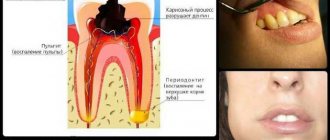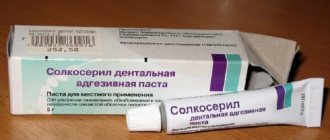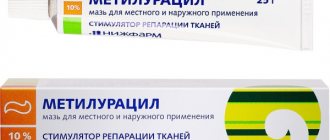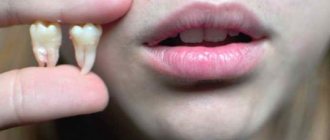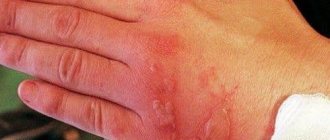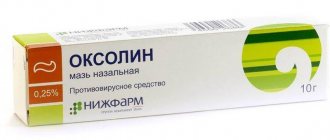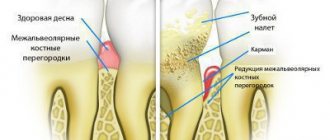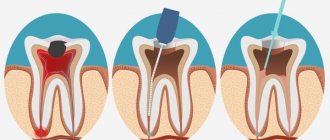Good day!
My name is Khalisat Suleymanova - I am a herbalist. At the age of 28, I cured myself of uterine cancer with herbs (read more about my experience of recovery and why I became a herbalist here: My story). Before being treated using traditional methods described on the Internet, please consult with a specialist and your doctor! This will save your time and money, since the diseases are different, the herbs and treatment methods are different, and there are also concomitant diseases, contraindications, complications, and so on. There is nothing to add yet, but if you need help in selecting herbs and treatment methods, you can find me at my contacts: Khalisat SuleymanovaInstagram page: instagram.com/fitoterapevt1
Telephone: 8
Email: [email protected]
I consult for free.
There are many ways to use Vishnevsky ointment for gumboil. But to do this, you need to become familiar with the symptoms of the disease and what consequences it brings. A beautiful smile is the calling card of every person. A healthy oral cavity is considered its key. To do this, you need to adhere to oral hygiene and promptly treat emerging diseases. After all, untreated caries and pulpitis can lead to a disease such as gumboil.
Flux is popularly called periostitis - inflammation of the periosteum with a purulent sac in the area of the tooth root. Periostitis is considered an acute inflammation. The disease occurs due to untimely treatment of caries and periodontal disease. The disease is accompanied by severe pain and if treatment is not started in time, it spreads to other tissues. This disease can occur at any age.
The main signs of the disease are:
- acute toothache,
- swelling of the mucous membrane,
- the appearance of a lump on the gum,
- temperature increase,
- general malaise.
At the early stage of periostitis, no abscess is observed. For this, doctors prescribe antibiotics, solutions and ointments. One of the effective methods is the use of Vishnevsky ointment for gumboil.
In order to choose the most appropriate treatment option, you need to know the etiology of the disease. So, the reasons for the development of the disease:
- infection in the gums or tooth tissue;
- mechanical damage, trauma or bruises;
- the presence of purulent tonsillitis or furunculosis;
- pulpitis, periodontal disease and advanced forms of caries;
- weak filling of the canals, due to which bacteria multiply.
INTERESTING fact: Beneficial properties of hawthorn and contraindications
What is tooth flux
Flux is the popular name for the diagnosis of periostitis of the jaw (inflammation of the periosteum). If untreated, inflammation of the pulp or periodontitis, the pathological process spreads to the periosteum of the jaw. If there is acute pain, swelling of the cheek and bump-like protrusions in the projection of the apex of the tooth root, then there is a suspicion of gumboil formation.
Every fifth dental patient is affected by the disease.
Periostitis requires mandatory consultation with a doctor. If this is not done, the jaw bone is affected and osteomyelitis develops.
Pathology, in turn, is dangerous due to blood poisoning.
Causes and symptoms of flux
The reasons for the development of periostitis of the jaw are as follows:
- basal cysts of teeth;
- periodontitis;
- the presence of abundant dental plaque;
- lack of treatment for caries;
- pulpitis;
- periodontitis;
- mechanical damage to teeth;
- poor oral hygiene;
- hypothermia of the body.
Flux is not an independent disease. It occurs as a result of lack of treatment or complications of other oral pathologies.
The process of formation of periostitis due to dental diseases can be considered in several stages:
- Untreated caries. This pathology affects only the hard tissues of the tooth. If caries is not treated, pathogenic microbes penetrate into the pulp chamber. As a result, more severe diseases begin to develop.
- Pulpitis. First, the tissue located in the crown of the tooth is affected. The inflammation then spreads to the root pulp.
- Periodontitis. It is a precursor to flux. The pathological focus of periodontitis forms directly near the root tissues. If the flux is left untreated, microbes quickly penetrate the periosteum, causing purulent lesions.
The main objective sign of the formation of gumboil is the deformation of the jaw from the vestibule of the mouth in the area of the root apex. Other symptoms of periostitis are as follows:
- swelling and redness of the periodontium;
- radiating pain from the affected tooth to the back of the head, jaw or chin;
- a sharp increase in pain response when chewing food;
- deformation of the cheek at the site of inflammation;
- development of intoxication of the body;
- headache;
- increased body temperature;
- poor general health;
- enlarged lymph nodes in the neck.
Attention! Sharp manifestations of flux are possible only in the acute stage. In the chronic course, there are practically no symptoms. The presence of periostitis for a long time leads to widespread damage to the jaw.
Local treatment of flux on the gums at home
It is impossible to get rid of the disease on your own. At home, it is only possible to relieve the acute manifestation of gumboil, for example, with folk remedies.
After surgery, the rehabilitation period takes place outside the hospital. When symptoms of the disease appear, it is allowed to take drugs such as Ketanov, Nimesil or Nurofen. These medications help temporarily relieve discomfort.
You should consult a doctor immediately at the first opportunity.
How to rinse gumboil on gums
All medicinal rinses should not be excessively hot or highly concentrated.
Failure to comply with these requirements may result in injury to affected and even healthy tissues.
How to rinse with gumboils and how to use the preparations? The most effective in this case will be the following antiseptic solutions:
- Furacilin. The pharmacy chain today sells the drug ready for use. During the day, rinsing is carried out up to 6-7 times. Furacilin has a pronounced antibacterial and anti-inflammatory effect. Allowed for use at home.
- Miramistin. Helps accelerate the flow of flux and the release of purulent exudate. It is strictly forbidden to swallow the drug. Use 3-5 times a day, especially after meals.
- Chlorhexidine. Negatively affects almost all types of pathogenic bacteria. Provides a pronounced regenerative effect on the wound. It is recommended to rinse up to 4 times a day with a 0.5% aqueous solution.
- Iodinol. It is a special analogue of iodine. A pronounced therapeutic effect of periostitis is observed at the stage of opening of suppuration. Before use, you need to dilute 1 tsp. in 150 ml of water. Rinse after meals up to 5 times a day.
- Hexoral. Ensures the fastest release of pus from the wound when used systematically. It is recommended to use as mouth baths and rinses every 4–5 hours. To treat flux, you need to prepare a working solution by adding one teaspoon per 250 ml of water.
Ointments and gels for flux
All products are used in the form of applications to the affected area. The ointment for flux is applied to a gauze napkin or a piece of bandage in a thin layer. Then apply to the mucous membrane and wait for a while according to the instructions.
Effective means are:
- Vishnevsky ointment. The tar in the ointment destroys bacteria, stops the formation of pus and relieves discomfort. The application lasts at least 2 hours. Allows you to break through the purulent sac and draw out its contents.
- Levomikol. Ensures rapid wound healing and kills bacteria. Used for any period of the disease. Apply for 2–3 hours.
- Metrogil-Denta. Dry the flux area before applying. Treatment is carried out by rubbing the gel. A positive effect is observed after 20–30 minutes. The product cools and numbs the pathological area.
- Ichthyol and streptocide ointment. Mix both products together in equal proportions. This composition is suitable if the gumboil has burst on the gum. Ichthyol ointment provides extraction of pus, streptocide provides healing and an antiseptic effect.
Properties of ichthyol ointment
Many people always have the drug in their home medicine cabinet because it has a wide spectrum of action. Ichthyol ointment has the following properties:
- antiseptic;
- disinfectant;
- painkillers;
- antipruritic;
- anti-inflammatory;
- keratolytic;
- regenerating;
- antimicrobial;
- antibacterial.
Ichthyol ointment is actively used to treat a huge number of skin diseases; it is used in gynecology, proctology, urology, and cosmetology. If you believe the reviews, it helps get rid of local symptoms of inflammation, promotes rapid healing and disinfects. Its advantages:
- Availability and reasonable price. You can easily and inexpensively buy ichthyol ointment at any pharmacy.
- Efficiency. The use of the product is guaranteed to give a positive therapeutic result.
- Ease of use. As a rule, the product is simply applied to the skin in its pure form.
Compound
The drug is produced in darkened glass jars or tubes. The composition includes only ichthyol (concentration 10 or 20%) and medical petroleum jelly. The main component is natural, produced by dry distillation of oil shale from sulfur. The medicinal composition is dark brown in color, viscous, like cream or toothpaste, and has a specific pungent odor. Ichthyol ointment is also produced in the form of suppositories. They are intended for insertion into the vagina or anus to treat diseases of the pelvic organs.
Folk remedies for flux
Alternative medicine, combined with medications, allows you to quickly get rid of any dental disease.
How to cure gumboil with folk remedies at home? To do this, use various decoctions of medicinal herbs, prepare mixtures for applications, and take infusions orally.
Garlic for gumboil
One of the folk remedies for gumboil is garlic. The plant has amazing properties. When garlic is chewed, the antibacterial substance allicin is immediately produced. The burning product is considered as a natural antibiotic.
To treat gum gum gum disease at home, chop or crush a clove of garlic. Then apply to the sore spot for 5–10 minutes. To rinse the mouth, crushed garlic is poured with water and left for several hours. The resulting solution is used to treat the mouth up to 5 times a day.
Rinsing with garlic tincture is effective. The solution is prepared by adding 10 drops of the product to a glass of boiled water. To make the tincture you will need 0.3 kg of garlic and 0.2 liters of alcohol. The crushed product is poured and left to infuse for 10 days. Then the resulting mixture is filtered and left for another 3 days in a dark place.
Attention! Treating gumboil with garlic at home requires caution due to the danger of causing a burn to the oral mucosa.
Calendula
Frequent rinsing during flux with folk remedies helps speed up the wound process. Alcohol tincture of calendula gives the desired effect. The product must be diluted before use. Half a teaspoon is thoroughly dissolved in 200 ml of water.
Calendula tincture provides a temporary calming effect. Can be used as a folk remedy in the complex treatment of gumboil. The oral cavity is rinsed up to 12 times a day. To enhance the therapeutic effect, you can add a tablespoon of aloe juice to the tincture.
Salt and soda for flux
A positive solution would be to rinse with a hypertonic sodium chloride solution. You can add baking soda to the salt mixture. To prepare the product you will need 150–200 ml of boiled warm water and 1 teaspoon each of soda and salt.
The solution promotes antiseptic treatment of the oral cavity and the release of purulent exudate from the wound. Thus, the flux will not spread to neighboring areas. Rinsing is carried out intensively, with an initial delay of the hypertonic solution for 30 seconds. on the side of the affected jaw. After 4-5 doses, relief comes.
Sage
To rinse the mouth during flux, pharmaceutical sage is often prescribed as a folk method of influence.
It is used both independently and in mixture with other components for the treatment of inflammatory foci:
- Mustard herb and sage. This folk remedy for gumboil soothes and relieves swelling of soft tissues. It takes 1.5 s. l. both substances. The mixture is poured into 1 liter of boiling water and left for 30 minutes. Rinsing is allowed up to 5–7 times a day without dilution. The decoction soothes and relieves swelling of soft tissues.
- Sage and St. John's wort. Herbs have a pronounced antiseptic effect on the infectious flora of periostitis. To prepare a decoction at home, you will need 2 tablespoons of dry product, which are poured into 0.5 liters of boiling water and kept in a steam bath for 0.5 hours. After cooling, strain 2 times and use every 3 hours until severe symptoms subside.
- Sage leaf and green tea. It will take 1 s. l. components. Sage and green tea can be purchased in bags, which are brewed and infused for 20 minutes. For flux in cases of severe suppuration, it is recommended to add 1 teaspoon of salt to the broth. Treatment with the folk remedy flux is carried out until the pathological focus completely disappears.
Attention! Folk remedies for treating flux can be strong allergens. Before using it at home, you must ensure that there is no negative reaction to the natural decoction or extract by performing a test.
Methods of use
Depending on the pathology, the method of using the ointment varies.
So, for boils and carbuncles, a gauze bandage should be applied to the site of inflammation, folded four times and soaked in ointment. This layer is covered with compress paper, after which the compress is fixed with a bandage.
The bandage should be worn for at least 10 hours. After removal, the skin is soaked with a paper towel and treated with salicylic alcohol. It will not only act as an antiseptic, but will also help get rid of a specific odor. Such dressings can be applied daily until complete recovery.
We suggest you read: Black plaque on the teeth from the inside, why blackness appears, reasons, how to get rid of whitening
For ulcers that have been opened, you should first wait until most of the pus comes out of the wound. During this period, bandages with antiseptic ointments are used. Only after a while is it possible to replace them with ones similar to Vishnevsky’s ointment. They are applied in the manner described above, changing every 5-6 hours.
The fight against bedsores with ointment should be carried out at the initial stages of their appearance. As soon as the skin of a bedridden patient turns red, a bandage with ointment should be applied. If the spots have turned into black bedsores, only surgery will help.
Ulcers in the lower extremities caused by varicose veins or trophic ulcers can also be treated with linemet. In this case, the product not only promotes the healing of lesions and acts as an antiseptic, but also increases blood flow, which allows the skin to recover on its own.
The dressing for these pathologies is done as follows: take a piece of gauze, fold it twice and apply Vishnevsky ointment to it. Then the bandage is applied to the ulcers and secured with a bandage. It should be changed 2 times a day. If there are varicose veins, then you should combine dressings with Vishnevsky ointment and similar ones soaked in heparin ointment.
Similar bandages applied for up to 4 days will help speed up the healing of wounds after burns and frostbite. Thanks to the action of the ointment, in such patients it is possible to enhance tissue regeneration, which leads to rapid healing of wounds and helps to avoid the formation of keloid scars.
The ointment is also used in gynecological practice - for inflammation, erosion. To do this, use tampons soaked in Vishnevsky ointment. They are inserted into the vagina for 2-3 hours.
It is believed that Vishnevsky ointment can also treat acne. First, you need to cleanse the skin, after which a gauze bandage with ointment applied to it is applied to the problem areas. Keep the bandage for 3-4 hours. For convenience, it can be fixed with adhesives. It is recommended to do this procedure twice a week.
Anti-inflammatory drugs for flux (NSAIDs, antipyretics)
When treatment with folk remedies for flux does not give the desired effect, traditional medications are used. Modern non-steroidal anti-inflammatory drugs have a number of advantages. They are harmless to the body, do not participate in digestion, and have no effect on blood clotting.
Can be taken at home according to instructions. Representatives of such funds are:
- Nimesulide. When taken systematically, it helps reduce swelling, local hyperemia and inflammation. The drug is prohibited during pregnancy and breastfeeding.
- Movalis. This is a strong analgesic that can even reduce body temperature. Movalis has a prolonged effect, so it is enough to take it once a day.
- Celecoxib. It has a pronounced analgesic effect and does not affect the digestive organs.
- Arcoxia. It quickly and permanently relieves pain, temporarily eliminating inflammation.
- Denebol. It is capable of providing an analgesic effect even with serious lesions. By eliminating swelling, pain reduction occurs quickly.
Is it possible to mix Levomekol and Vishnevsky ointment?
Mixing ointments with each other is not recommended. The reason for this is that Vishnevsky's liniment has a fatty base, it is lipophilic and penetrates deep into the tissue. Levomekol ointment, on the contrary, is hydrophilic, it is on the surface and is not absorbed into the bloodstream.
Often these two drugs are used sequentially. For example, first liniment is used to draw out pus, and then Levomekol is used to accelerate tissue regeneration.
Both products are good - they are time-tested, effective, safe and inexpensive. But, with a similar effect, they need to be used at different stages of the disease. Therefore, the doctor must determine which drug to use, how and for how long.
Antibiotics for flux
Antibacterial therapy is mandatory, since it is impossible to cure flux on the gums without them using traditional methods alone. Therapy involves the use of agents that affect gram-positive and anaerobic bacteria. The course of antibiotic treatment for flux is 10 days. Most often, dentists prescribe Metronidazole with Lincomycin or Clindamycin. In dentistry, preference is given to the latter drug.
General-spectrum drugs are also used for treatment:
- Sumamed;
- Amoxiclav;
- Unidox Solutab;
- Flemoxin;
- Digital
In case of diabetes mellitus and lack of therapeutic effect due to changes in the sensitivity of microflora, drugs based on Norfloxacin or Ofloxacin are indicated. It is difficult to cure gumboil in such conditions. The main representatives of the funds are:
- Syphlox;
- Tarivid;
- Nomitsin.
Is it necessary to visit the dentist?
Why treat flux if over time the lesion will open on its own, and antibacterial therapy will help eliminate purulent formations? This is often the opinion of uninformed patients. In fact, failure to treat flux at the dentist leads to dire consequences:
- Abscess. It is a limited purulent inflammation. Occurs with prolonged flux and lack of treatment.
- Phlegmon. It is a diffuse inflammation of soft tissues with the formation of pus. Swelling and pain increase. Cellulitis forms after the rupture of a purulent sac during periostitis.
- Osteomyelitis of the jaw. This is a purulent-necrotic lesion of bone tissue. With a long course of flux, the pathological focus spreads to all neighboring areas. Osteomyelitis is often complicated by sepsis, leading to death.
- Inflammation of the maxillary sinuses. Pus spreads quickly through the airways. The maxillary sinuses are affected when the flux is localized on the upper jaw, from the canine to the first molar.
Indications and contraindications for use
Use is contraindicated in case of hypersensitivity to the main active ingredient – ichthammol. Ichthyol ointment is most often used for acne, but similar medications are also used to treat other problems. Standard indications for the use of this drug are a variety of skin diseases, such as:
- Eczema,
- Burns,
- Abscesses,
- Black dots,
- Erysipelas.
In addition, the drug is prescribed for the complex treatment of arthritis or neuralgia, if it is inflammatory or traumatic in nature. Ichthyol ointment is used in gynecology and urology. With its help, they affect inflammation of the pelvic organs. For example, the medicine is used for prostatitis, parametritis and metritis, as well as salpingia.
Ichthyol ointment for hemorrhoids works against hemorrhoids. It helps slow down the inflammatory process and reduce the degree of pain. Gradually, the product restores tissue, and thus healing of cracks occurs. Due to the effect on blood vessels, there is an outflow of venous blood and a general improvement in blood circulation in the treated area. The medicine also helps eliminate discomfort and itching.
Since the medication is based on natural ingredients, it has virtually no contraindications. Ichthyol ointment is approved for use during pregnancy. You cannot treat the skin with the product if you are individually intolerant to the composition, and it is also prohibited to give it to a child. Side effects are limited to allergic reactions such as burning, itching, skin rashes and redness.
Ichthyol ointment has no contraindications, so pregnant and lactating women can use it as treatment, but only after consultation with their doctor.
